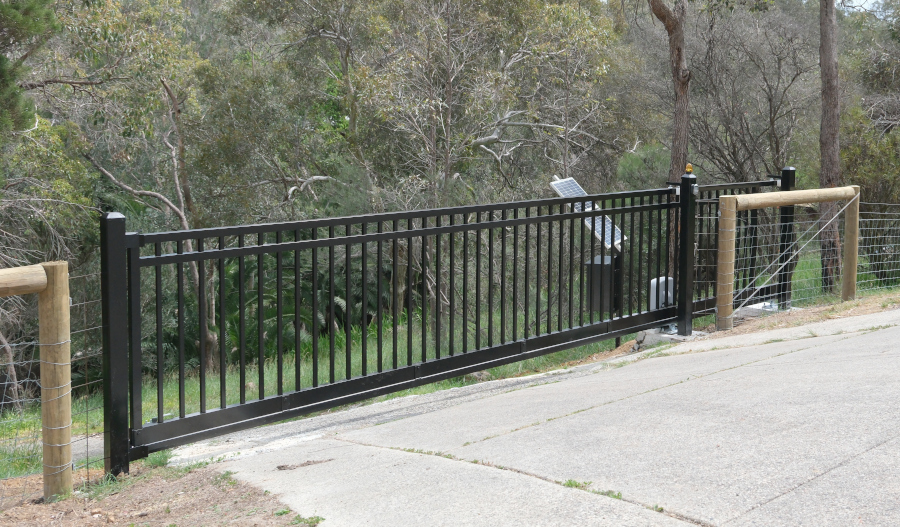Solar-Powered Driveway Gates: Energy Savings to Shrink Your Carbon Footprint

A motorised gate that swings open at the touch of a remote has long been a marker of convenience and security. Until recent years, though, it also guaranteed a permanent draw on the mains. A small stand-by load, plus the surge each time the motor turned, added up to a steady trickle of electricity. Fit a photovoltaic (PV) kit and that trickle disappears. By running the operator from a panel and battery bolted to the post, households can trim power bills, cut greenhouse gases and keep the driveway working even when storms bring the lines down.
How Much Energy Does a Gate Use?
Most domestic swing or sliding drives use a 24-volt DC motor. The control board and receiver idle at about 5 W. Opening or closing a light steel leaf needs roughly 150 W for twenty seconds. Ten full cycles a day burn 0.03 kWh in motion plus 0.12 kWh in stand-by—about 0.15 kWh daily. Across a year that reaches 55 kWh, enough to power an efficient fridge for a fortnight.
Sizing the Solar Pack
Perth averages 5.8 peak-sun-hours in summer and 3.5 in winter. Even in July a 40 W panel paired with a 12 V 9 Ah battery clears the daily 0.15 kWh with margin. Installers generally favour 60 W or 80 W modules to feed accessories such as keypad lights or a Wi-Fi camera. The upgrade adds just two wires—one from panel to regulator, one from regulator to battery, to keep labour at a reasonable level.
Dollars Saved and Payback
A PV gate no longer takes from the grid. Annual savings equal the 55 kWh not bought from the retailer. Western Australian tariffs have climbed about three percent a year since 2014, so over time the avoided spend grows. Skip trenching for mains cable and the numbers look even better—rural drives can swallow thousands in excavation.
Counting the Carbon
The regional grid emits about 0.70 kg of CO₂-e per kWh. Dodging 55 kWh each year prevents 39 kg of emissions. Over fifteen years that is nearly 600 kg—about the same as driving a small hatchback from Perth to Sydney. For homes aiming for net-zero, every kilogram shaved off the ledger helps.
Blackout Resilience
Savings draw the eye, yet security often seals the deal. When a storm knocks out the lines, a PV-charged battery keeps the gate alive for days. Dairy farmers maintain stock control, delivery drivers roll in without fuss, and you avoid the awkward sprint through rain to operate a manual latch.
Choosing the Right Package
Solar kits bolt onto new builds and retrofits. Homeowners browsing ready made gates Perth will find frames that look identical to mains-powered units; only the small panel and weather-sealed battery box give the game away. Expect the Ready made gates Perth cost for a solar variant to run 10–15 percent higher than a conventional package.
Search results for ready made gates near me can be overwhelming, so press retailers on three points:
- Duty cycle – how many openings per hour can the motor tolerate?
- Battery capacity – aim for at least three sun-free days.
- Warranty – electronics live outdoors; two years is minimum, five is better.
National catalogues carry readymade gates for home pre-wired to accept a panel, and a local installer can add the solar hardware during assembly.
Bargains and Second-Hand Stock
You might stumble across ready made gates for sale at half price because a model is being superseded. The saving is real only if the controller meets current safety rules and spare parts remain available. An outdated charger without temperature compensation can cook batteries in summer and wipe out any bargain.
True Cost of Ownership
Sticker price is only one slice of the pie. The readymade gate price must be weighed against trenching, ongoing electricity, blackout downtime and the intangible value of lower emissions. Once those costs and benefits are tallied, a solar-equipped unit usually comes out in front.
Verdict: A Small but Meaningful Step
A well-specified solar gate turns a sliver of fence line into a micro-renewable power station. For households seeking the best ready made gates for reliability, running cost and sustainability, going solar is a clear contender. The maths is straightforward, the carbon cuts are measurable, and the extra resilience when the lights go out is hard to ignore.



